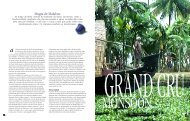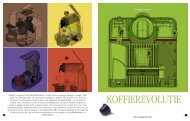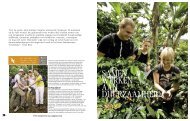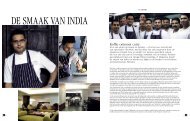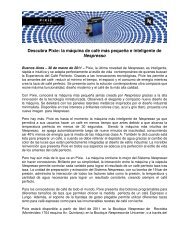Create successful ePaper yourself
Turn your PDF publications into a flip-book with our unique Google optimized e-Paper software.
Monsoon<br />
GRAnD CRU<br />
Travel&more<br />
<strong>Malabar</strong> <strong>Magic</strong><br />
Along India’s southwestern coastline in Kerala, where the biodiversity stemming<br />
from heavy rainfall is now recognized as a worldwide attraction, coffee isn’t the<br />
only thing that can undergo a unique transformation. Visitors do, too.<br />
EDITOR: Anuj DesAi PhOTOgRaPhER: Peter GArmusch<br />
30 31
32<br />
Above: Weavers in Kerala are<br />
returning to their traditional<br />
use of Ayurvedic textile dyes.<br />
Right: Fishermen at Hosabettu<br />
Beach as the sun sets over the<br />
Arabian Sea.<br />
Previous: Boats are the only<br />
form of transport in Kerala’s<br />
backwater region.<br />
Above: Kerala’s history is largely<br />
tied to its commerce, including<br />
the spice, tea, and coffee trade<br />
that still attracts travellers from<br />
around the world.<br />
Left: Water buffalo splash<br />
through a simulated rice paddy<br />
during a traditional “kamla”<br />
race in Karnataka.<br />
s outh Asia’s fabled monsoons linger long after<br />
the rain is gone. Crisp, brown earth turns green.<br />
The silence of wildlife brought on by a torrential<br />
downpour gives way to a clamour of activity – animals<br />
emerging, insects calling, humans honking. Seasonal life<br />
is awakened, while other signs of life are deluged. Life on<br />
all levels is altered during this period of intense downpour<br />
spanning June to September that accounts for nearly 80% of<br />
India’s annual rainfall. Nothing and no one escapes this rain.<br />
But despite all the shared change that the Indian subcontinent<br />
undergoes, monsoon in the southwestern coastal state of<br />
Kerala has its own unique transformative processes.<br />
One such example involves coffee. Through exposure to the<br />
monsoon air, nowhere else in the world can season coffee<br />
beans (primarily grown elsewhere) like Kerala. Kerala’s<br />
position along the Indian coast makes it the first area to<br />
receive southwest monsoon showers from the Arabian Sea,<br />
and the proximity of mountains to the ocean results in a<br />
particularly high amount of rainfall (up to 250cm annually).<br />
What coffee connoisseurs have discovered is that the qualities<br />
of Kerala’s rainfall enable the region to produce a type of<br />
coffee that no other place can: monsoon coffee (or Monsoon<br />
<strong>Malabar</strong>, named after the coastline). Bringing beans into<br />
contact with the salty, moist air along Kerala’s coast weathers<br />
them in a way that changes both taste and colour. Experts<br />
have tried to replicate this process elsewhere, but with no<br />
success. To the locals, that failure is no surprise. Instead, it is<br />
evidence of what they’ve known all their lives – that Kerala’s<br />
monsoon is distinct. The air is uncommonly heavy with water<br />
and salt, and the wind constantly blows from the ocean inland<br />
at an optimum angle.<br />
Of course, in a region where the biodiversity stemming from<br />
heavy rainfall is now recognized as a worldwide attraction,<br />
coffee isn’t the only thing that can undergo a unique<br />
transformation in Kerala. Visitors do, too.<br />
This thin slip of a state primarily bounded by the Arabian Sea<br />
and the Western Ghat mountains ranks among the world’s<br />
unique eco-systems; it is home to several forms of classical<br />
Indian dance and music celebrated around the world; it is<br />
the site of both ancient ruins and cosmopolitan influences<br />
from centuries ago; and it is an area famous for spices like<br />
cinnamon and pepper along with coffee. The most fascinated<br />
travellers to Kerala, however, are those who have experienced<br />
their own mildly transformative process courtesy of one of<br />
the countless lifestyles being lived out in a state smaller than<br />
Switzerland. From tropical culture to ancient Ayurveda – the<br />
ancient medical practice meaning “science of life” that was<br />
founded in this area – Kerala is like no other place in the<br />
world because it harbours so many ways of life.<br />
Tropical Venice<br />
Sunrise over Kerala’s lush backwater region. Along this web<br />
of waterways and dense palm groves that spans hundreds of<br />
kilometres near India’s southwestern coastline, the scents of<br />
morning fires, jasmine, and brine fill the air. Local residents<br />
who live on diminutive plots of land and travel in boats<br />
begin their morning scrubbing of limbs, laundry, and vessels.<br />
Prayer follows bathing. Temple bells ring. Exotic bird calls<br />
– especially those of the Kingfisher – are so frequent and shrill<br />
that the unsuspecting visitor is likely to mistake these regular<br />
calls for a signal of panic.<br />
Ayisha Manzil, Court Road, Tellicherry, +91.490.2341590. A hillside<br />
inn overlooking the sea offers cooking classes, and some of the best<br />
food that the world has yet to discover.<br />
Brunton Boatyard, 1/498 Fort Cochin, Cochin, +91.484.2364485,<br />
www.cghearth.com. An ideal gateway to Kerala, Cochin is a town that<br />
has known Bohemian, Chinese, Arabic, Jewish, Portuguese, Dutch,<br />
and English influences in its time. Overnight at this sister property of<br />
Marari Beach before heading to the backwaters.<br />
Fabindia, Thamarapally 39/4749, Old Thevara Road, Cochin,<br />
+91.484.3267682, www.fabindia.com. An excellent national crafts shop<br />
where prices are reasonable and fixed, products are eco-friendly, and<br />
artisans receive a fair cut.<br />
Harivihar Ayurevedic Heritage Home, Bilathikulam, Calicut,<br />
+91.495.2765865, www.harivihar.com. A house of relaxation for some; a<br />
school in Ayurveda, vastu, yoga, and more for others.<br />
Rainbow Cruises, V.C.N.B Road, Alleppey, +91.477.2241375,<br />
www.backwaterkerala.com The houseboat company part owned by<br />
South Indian film star Jairam (ask for his Gold boat) is an ideal way to<br />
experience Kerala’s backwaters.<br />
ENS Kalari, Embram Madam, Nettoor, +91.484.2700810,<br />
www.enskalari.org.in. The renowned home to the world’s first martial<br />
art offers demonstrations. More of a way of life than a combat<br />
technique, kalaripayattu also blends principles of yoga and Ayurveda.<br />
Dubare Elephant Camp, Dubare, Kushalanagar, +91.944.9599755,<br />
www.junglelodges.com. If you continue to journey through India,<br />
Kerala’s neighbouring state, Karnataka, offers a unique wildlife<br />
sanctuary.<br />
33
34<br />
As any fascinated visitor drifting past this scene with a<br />
coconut in hand will tell you, Kerala’s backwaters make up<br />
the most idyllic (but little known) setting in the world. The<br />
water culture along the celebrated inlets is best taken in by<br />
booking a private houseboat in Allepey. These houseboats<br />
come complete with several bedrooms for sleeping, and crews<br />
who guide travellers through the waterways while cooking all<br />
their meals. Allepey, which is part of the northern backwaters<br />
region, consists of six so-called lakes and countless narrow<br />
waterways between them. So prevalent is the water and so<br />
scarce the land that, like Venice, all transportation is done by<br />
boat. One canal – No 47 – is even listed as a national highway.<br />
Taking the 47 is like floating through your very own trivia<br />
question, and if that’s not a unique travel experience, what is?<br />
Life on the Beach<br />
After experiencing life on the tropical backwaters, coastal<br />
culture follows – specifically, the delicious centuries-old<br />
fusion fuelled by trade that has taken place along the <strong>Malabar</strong><br />
Coast. Cultural immersion is most fun when it involves food,<br />
and the charming Ayisha Manzil, an inn on a hill overlooking<br />
the sea, has set mouths watering as far away as Lyon and<br />
Chicago. An 11-year partnership between C. P. Moosa and his<br />
wife Faiza, Ayisha Manzil is one of the unique inn experiences<br />
to be found in the world, largely due to the exquisite but rare<br />
Mopillah cuisine that originates from Faiza’s kitchen. Her<br />
dishes, which come from a relatively small community of<br />
regional Muslims, are taught to interested guests, who all<br />
leave with a cookbook and frying pan to go with their<br />
memories.<br />
Faiza describes Mopillah cuisine as a “symphony of flavors”<br />
more delicate than one might expect of its Indian and Arab<br />
influences alone. While some of her outstanding dishes<br />
include kannanpatiri (eyelash bread), tamarind prawns,<br />
pickled dates and raisins, her own favourite is the biryani,<br />
the spice-infused rice and meat favourite of northern Indian<br />
cuisine whose origins are originally <strong>Malabar</strong>i.<br />
To work up an appetite, the tranquil Ayisha Manzil pool or<br />
its nearby beaches are recommended. During the local festival<br />
season, the Moosas also offer tours of the village theyyam<br />
performances. Theyyam, an ancient form of dance-theatre<br />
focusing on reenactments of religious tales, lasts for several<br />
days and nights, providing the unsuspecting viewer with a<br />
rare, near-magical combination of colourful costumes and<br />
face paint, live music, fireworks, performers trained to invoke<br />
deities, and both acted and genuine trances by performers and<br />
villagers alike.<br />
The final capture of coastal culture is, of course, the isolated<br />
beach. The Marari Beach resort is a secluded getaway with a<br />
conscience, the kind of place where the average stay is over<br />
a week and the roster of well-intentioned guests includes<br />
Paul McCartney. Started in 1998 by the eco-friendly luxury<br />
chain CGH Earth, Marari consists of 62 cottages spread over<br />
37 private beachside acres inside which no trees were cut,<br />
no soil was removed, and all the lakes were preserved during<br />
conversion. Dry, fallen leaves are collected for composting,<br />
and the property has its own organic garden to supply the<br />
restaurants. Look up for a dozen types of bananas.<br />
Health as Wealth<br />
No tour of Kerala’s lifestyles is complete without experiencing<br />
Ayurveda, the 5000-year-old Hindu practice undergoing a<br />
worldwide revival today. The Harivihar Ayurevedic Heritage<br />
Home in Calicut is both a guesthouse and a centre for<br />
Ayurveda. The property was started three years ago in a 150year-old<br />
house now owned by the Kumars, a husband and<br />
wife duo who are practising MDs and who also believe in an<br />
Ayurvedic lifestyle. (Harivihar happily accepts people who are<br />
uninterested in Ayurveda.)<br />
Dr. Sri Kumar, a paediatric neurologist, calls his property a<br />
“lifestyle house”. Light vegetarian food makes up the menu. No<br />
alcohol or smoking is allowed indoors. The chief instructor<br />
in Harivihar’s lifestyle is Dr. Mali, an Ayurvedic doctor of 18<br />
years. While the programs that Dr. Mali offers can be started<br />
in 7 days, “we suggest at least 15 days’ stay,” he says. Ayurveda,<br />
he reminds us, is “not the science of treatment” as much as it<br />
is a process of learning a new lifestyle and “clearing impurities<br />
and toxins from various biochemical changes occurring in<br />
your body”. The education is one that most guests appreciate<br />
greatly – some 60% of them make return visits.<br />
Those who come to Kerala leave with that which the best<br />
sightseeing experiences offer: memories that last a lifetime.<br />
But the luckiest of visitors to this tiny coastal state take with<br />
them a souvenir that changes their own way of living. Because<br />
while the shades of green are plentiful in Kerala, the land is<br />
bountiful for another kind of yield – its rich crop of lifestyles.<br />
Below: A face from Theyyam,<br />
Kerala’s 2000 year-old<br />
performance art practised<br />
throughout regional villages.<br />
Ritual theatre and dance<br />
festivals last for days and<br />
nights as episodes from<br />
religious texts are reenacted.<br />
Above: Demonstration of<br />
kalaripayattu, the world’s<br />
oldest martial art, by students<br />
of the celebrated ENS<br />
Kalari. More of a way of life<br />
than a combat technique,<br />
kalaripayattu also combines<br />
principles of yoga and<br />
Ayurveda.<br />
35
36<br />
Above: Trained female<br />
coffee garblers (final<br />
sorters) for monsoon<br />
beans of Aspinwall & Co.<br />
Ltd.<br />
Right: Farmers sorting<br />
cherries at Thippanahally<br />
Estates, a farm that in<br />
addition to 2500 acres of<br />
Arabica beans also boasts<br />
rabbits, peacocks, and<br />
occasional leopard.<br />
special Club 2007*<br />
JAlAyAtRA Coffee<br />
India<br />
Bangalore<br />
Jalayatra celebrates the marriage of two distinct Indian Arabica coffees: the full-bodied Monsoon<br />
<strong>Malabar</strong> tempered by the juiciness and softness of India Plantation. The result is an unforgettably<br />
bold and creamy Espresso Grand Cru accented with notes of nutmeg and clove.<br />
Like wine, coffee’s uniqueness is traced to its soil – a variety<br />
is documented, named, and celebrated based on the region<br />
where it is grown. But in the case of Jalayatra, Nespresso’s<br />
latest Special Club, while all of the coffee that makes up the<br />
blend is from a single country – India – its defining trait is<br />
cultivated well after the bean has been grown, picked, and<br />
transported from the elevated regions of its origins down to<br />
sea level.<br />
Specifically, over 60% of the Jalayatra blend consists of coffee<br />
beans that are said to be monsooned. The monsooning of<br />
coffee in the southwestern India state of Kerala today refers<br />
to a weathering of the bean that involves exposing it to the<br />
moist, salty air that blows inland from the Arabian Sea. Others<br />
have attempted to re-create this process all over the world,<br />
and even along other coastal regions of India, but nothing<br />
compares to coffee that is laid out to dry in this region. No<br />
other place seems to get the sustained humidity of Kerala, says<br />
V. G. Coelho, managing director of Coelho’s Gold coffee and<br />
a supplier for the Jalayatra Special Club 2007 blend. “And the<br />
wind blows in one direction only – inland.”<br />
The monsooning of picked beans runs during the torrential<br />
rain season that spans from June to September. The process<br />
starts with spreading beans out in a single layer on cool<br />
floors that are covered from above but open on all four sides.<br />
These sheds must be nearby the ocean in order to expose<br />
each batch of beans to Kerala’s humid, salty coastal winds for<br />
approximately 20 days.<br />
Thiruvananthapuram<br />
According to legend, monsooning’s origins stretch back to a<br />
series of accidents that began in the 1600s. At the time, ships<br />
from India had to travel six months to get to Venice for its<br />
European distribution. Beans were kept in the musty bowels<br />
of the ships, resulting in beans that started out brown arriving<br />
at port golden in color. For many Europeans, it was the only<br />
coffee they knew – until shipping conditions improved in<br />
the mid-1800s. When brown beans arrived in steam ships in<br />
Venice, many Europeans rejected them, instead preferring<br />
coffee that had been weathered by the slow sail across oceans.<br />
Indian coffee growers who had joined the international<br />
market by then started to meticulously reproduce the old<br />
sailing conditions for their beans on land.<br />
Besides colour and taste, bean texture, density, and size are<br />
also transformed during monsooning. They also drop their<br />
acidity levels, gain spicy, woody notes, and maltiness, and<br />
evince a better crema texture in Espresso blends. When mixed<br />
with the Indian estate coffee used in Nespresso’s Special Club<br />
2007, a softer and less wild flavor is gained.<br />
But most compelling are the characteristics of Jalayatra that<br />
are off the charts. When you consume Jalayatra, you are<br />
reaping the benefits of an accident of centuries ago, and the<br />
modern-day preservation of it. You are sipping the earth of<br />
the coffee’s origin and the salty ocean next to which it has<br />
rested, all mellowed by a happy accident. Drink in the storm.<br />
*The Special Club is available only while stocks last.<br />
37











